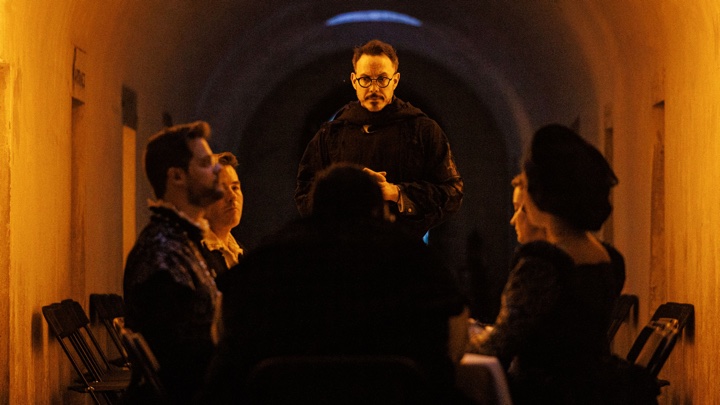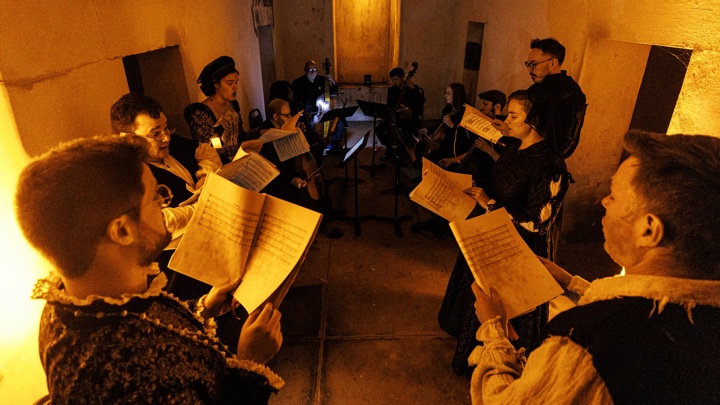

Recent entries in their season include Burgers, Bourbon, and Beethoven, and, two weeks ago, Tacos, Tequila, and Tavener’s Protecting Veil. It’s a clever move, making the pre-concert hour feel more like a cocktail party, spotlighting local brands, justifying the trek out to Sunset Park for Manhattan audiences, and making us all the more positively inclined to the concert. As Moodymann intones in a sample on Drake’s “Passionfruit”: “Y’all get some more drinks goin’ on, I’ll sound a whole lot better’—not that these musicians need it, of course, but a few libations can’t hurt.
The party vibe is a lot of fun, especially in the golden window of early summer when the perfect temperatures can trick us all into thinking that summer in New York is magical, at least for the first few weeks. At times, however, this breezy tone can conflict with the content of the performances themselves, as was the case with Secret Bryd; religious persecution just isn’t all that fun. Instead, we were in for a contemplative evening, considering what it means to make art under duress.
Directed and created by Bill Barclay, an early music expert whose career highlights include serving as the music director for the Globe Theater, Secret Byrd stages Byrd’s short and stunning Mass for Five Voices, cutting it and splicing it with other works, both vocal and instrumental, by this famed Renaissance composer..
In his later years, Byrd became an increasingly devout Catholic at exactly the wrong time in English history to do so: As Queen Elizabeth was tightening the laws against Catholic recusancy, making it illegal for subjects to practice it, and treason to harbor Catholic priests.
The Mass for Five Voices was likely written in 1594, perhaps without any particular hope for public performance, and likely sung in secret by small groups of devoted worshippers in the house of Byrd’s patron Sire John Petre. This performance was not the premiere: Secret Byrd has come to New York after successful performances in the Washington National Cathedral in Washington, D.C earlier this spring.
Written in terrible political circumstances, the Mass for Five Voices is a both a testament to Bryd’s bravery and a piece whose history looms large around it, threatening perhaps to overwhelm it. Secret Byrd staged both the piece and its history in a unique, intermittently moving, but not always entirely successful metatextual endeavor that took place in Green-Wood’s nineteenth-century catacombs.
Actors dressed in resplendent Tudor garb led us into the tunnel-like crypt, warning us to be quiet and not to reveal that we had been here to anyone (too late on that front, I guess), while also directing us to lighted program notes scattered throughout the alcoves. Halfway down the tunnel was a table, set with historical looking tableware and tea-aged scores for the singers (drawn from the Cathedra ensemble, from Washington, DC,) while the similarly-costumed Abendmusik were arranged at the very end of the passage.
What followed was a staging of a staging of Byrd’s mass; the singers playing Catholics singing Byrd’s mass at a clandestine dinner with a fugitive priest, played by Barclay himself. A few VIPS got to sit at the table with the singers, (I did not, though I had an excellent view of both ensembles), and share a fake meal with them.
In between movements of the Mass, Abendmusik worked through a program of Bryd’s instrumental music, playing with calm elegance from their back corner. As we moved through the Mass, singers moved through the space, dipping into the alcoves for a brief confession, or kneeling before us on the stones.
The climax of the performance was non-musical; it came in form of a frightening interruption as someone banged loudly on the metal door, a gesture to the terror of discovery by Protestant forces that surely haunted the earliest performances of this work. The singers then rushed around, loudly shushing the silent audience and flicking off the electronic candles, while we waited for the threat to pass, shivering in the freezing darkness and getting increasingly creeped out.
This was the most powerful mobilization of the performance’s premise, which conceives of this music as surrounded by threat, both existential and musical, and vulnerable to interruption. Returning to song after that silence, it argued, is very brave indeed. As an idea, Secret Byrd was fascinating, if for nothing else for the questions it raised about performance and devotion.
At the heart of the Catholic Mass is the theatrical re-enactment of the Last Supper. Musical masses offer new “productions” of the familiar words; re-setting them so that their hearers and singers encounter them anew. By staging the Mass in a context that is stripped of much of the trappings of Catholic worship, Secret Byrd was a performance of a performance, couched in a context in which the performativity has been stripped away, leaving only private devotion that was here made public.
In practice, it was somewhat awkward, mostly because of the insistence on the partial performance of actual Catholic rituals. Barclay, dressed as a priest, could neither fully embody his role, as he is not actually a clergyman from what I can tell and thus can’t perform any real rites, nor could he fully absent himself from the proceedings. He occasionally offered light musical cues to his ensemble, but for the most part he gestured solemnly and offered blessings and even confession to both his singers and his audience.
While we were graciously invited to participate, I can’t really imagine what type of confession I’d make to a music director dressed as priest (“I didn’t practice last week?”) Apparently neither could anyone else in the audience, as no one took him up on his offer. He offered blessings to us, followed bits of bread (unconsecrated as if offering us hors d’oeuvres at a cocktail party. These gestures, meant to bring us into the world more closely, were more alienating than inclusive, because they called far too much attention to the staged nature of the event.
What worked very well indeed, however, was the singing: The five members of Cathedra ensemble blended together with a noticeable warmth and sweetness, while retaining a clear balance between each of the parts. Around the midpoint of the concert, mezzo soprano Aryssa Leigh Burrs treated us to touching and mournful rendition of “Ye Sacred Muses,” Byrd’s elegy on the death of Thomas Tallis which includes the lines, “Tallis is dead, and Music dies.”
The brilliantly live (irony intended) space of the catacombs, combined with the intimacy of the setting, allowed the singers room to explore the finest details of Bryd’s exquisite, shifting textures. This score aches with devotion, pain, and finally, with a tiny thread of hope.
Photos: Sachyn Mital


























Comments